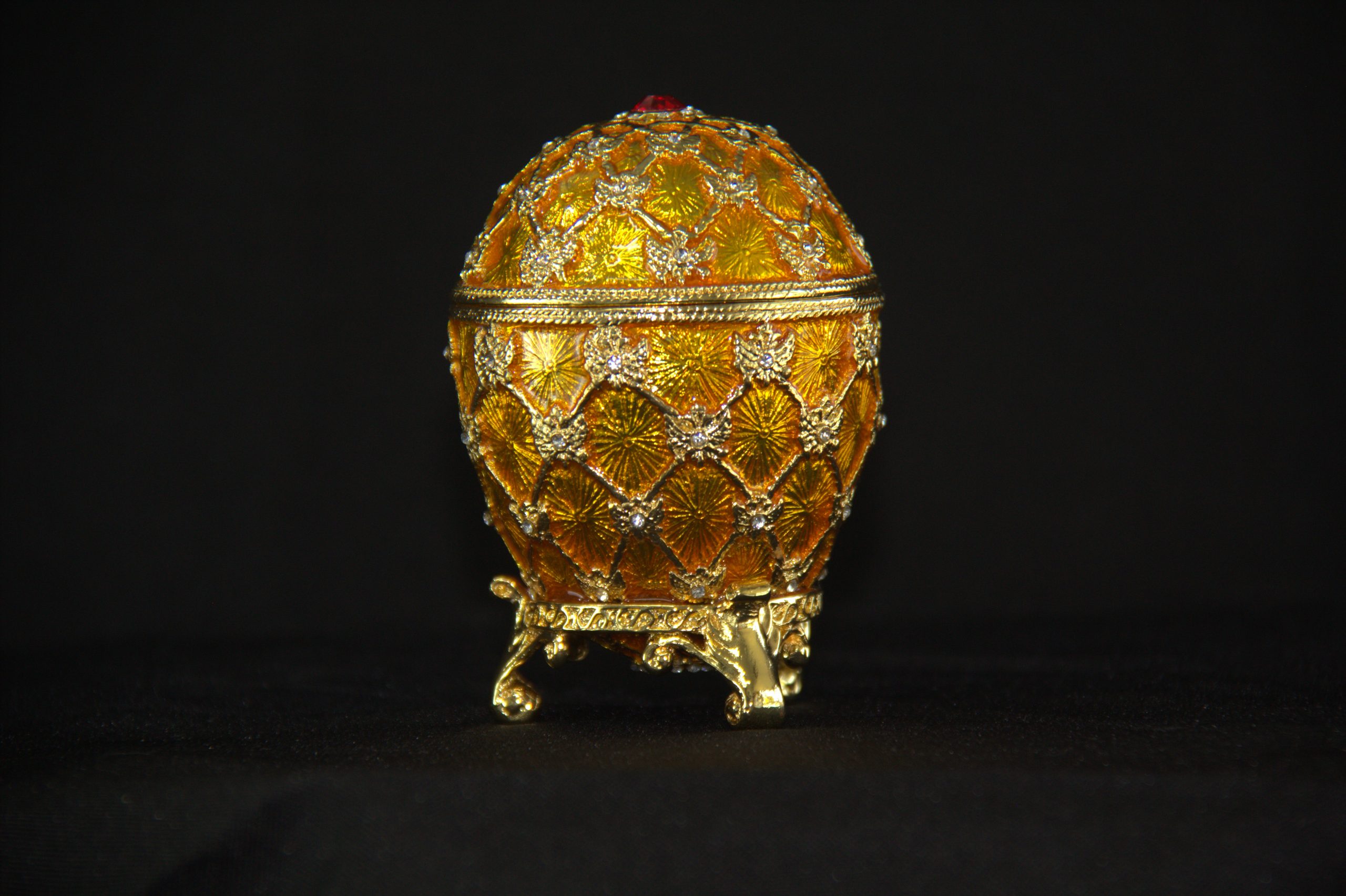Faberge eggs are intricate and beautiful pieces of art. The most talented artisans have worked on Faberge eggs. Each egg was made to celebrate and remember an essential part of history. Also, they are costly to own, but many have now been relocated to the Faberge Museum in Russia. However, people from all over the world still travel to Russia to catch a glimpse of these magnificent pieces of art. This post is going to be focusing on the Coronation Faberge Egg.
Origin of the Coronation Faberge Egg
This beautiful gold egg was created to commemorate Empress Alexandra Feodorovna, the Tsarina. Her husband, Tsar Nicholas II, was the one who got the egg made. The egg is made of gold and has a translucent yellow-lime enamel that can be found on the guilloche area. Also, the guilloche was placed in an area of starbursts. Moreover, the designers were able to reference the gold cloth robe that the Tsarina would then wear at her coronation.
On the egg, you can see a web of bands made up of gold-greenish laurel leaves that were cleverly placed at every intersection. Also, every intersection has a gold imperial double-headed eagle made from opaque black. They used a rose diamond on the eagle’s chest to set it. The reason for this pattern is that it was found on the coronation robe that the Empress wore.
When you look at the top of the egg, you can see a large portrait diamond surrounded by 10 smaller but beautiful diamonds. Additionally, if you were to look through the diamond, you would see the monogram of the Empress. In the smaller area, there is a smaller cluster of diamonds that have been surrounded by a flower motif made of 20 narrow gold petals.
The smaller end of the egg also has the date 1897 engraved, but diamonds cover it. Additionally, the egg was also presented with a glass-enclosed stand. This stand was made with 5,650 rubies and was a way for the Empress to display the carriage found inside the egg. However, the stand was lost and has never been found again.

The story of the Faberge Carriage
This carriage has the Imperial Crown on top in rose diamonds with matching six double-headed eagles on the roof. The windows were fitted with rock crystal, and the tires were platinum with a gold diamond trellis. Also, both doors had the imperial eagle in diamonds on them.
Inside the real egg, the designers created a replica less than 100 millimeters long of the 18th century Imperial carriage. This carriage was what brought the Empress to her Coronation in Moscow. The carriage was red, and the artisans used translucent, enamel-colored strawberry red to match the carriage. Additionally, the upholstery was blue on the interior of the carriage, so the designers used blue enamel to reproduce it.
The miniature carriage was made with opening doors, moving wheels, a miniature folding step-stair, and C-spring shock absorbers to complete the surprise. However, there are pieces of the surprise that are missing. The pendant that hung inside the carriage, the jadeite stand, and the silver-gilt wire stand have all disappeared.
In order for the carriage to be made, George Stein, who was the creator of the carriage, spent nearly 15 months going to the royal stables, so he could examine the carriage. Also, sometimes he would be there for 16 hours to make sure he had everything perfect. However, after spending so much time creating the carriage, he used the money he received to purchase a bike as his form of transportation.
Who Created the Egg?
The Coronation Faberge Egg was made under the supervision of Peter Carl Faberge, a Russian jeweler. In 1897, this egg was made by Henrik Wigstrom and Mikhail Perkin, who were both two of the best Faberge ateliers.
Impact on the Faberge Field
There was no impact on the Faberge field after the Coronation Egg, but it was the most lavish egg ever created. The original carriage inside the egg sets the Coronation Egg apart from the other eggs because of the incredible detail found.
Current location and the journey over the years of the Coronation egg?
Obviously, the first owner of the Coronation Egg was Tsarina Alexandra, and she received it on Easter in 1897. She kept the egg at the Winter Palace in St. Petersburg and displayed it there while it sat in a jeweled carriage. When the Romanov Dynasty fell, the egg was then taken by the Provisional Government in 1917.
After this, it was given to the Kremlin before it was sold to the Sovnarkom in 1922. In 1927, the egg was then bought by Emanuel Snowman for Watski, a family-owned business that specialized in art and antiques in London. Then, the egg was sold to Charles Parsons in 1934 but was taken back by the Wartski in 1945 and stayed there until 1979.
In March 1979, Malcolm Forbes bought the Coronation Egg with the Lilies of the Valley Faberge Egg for $2.16 million. Along with seven others, these eggs were then kept until 2004 before being sold by the Sotheby’s Auction House. However, before being able to sell them in the auction, all the Faberge eggs, and 180 other Faberge art pieces were taken off the auction and privately sold to Viktor Vekselberg.
Now, the Coronation Egg can be seen in the Faberge Museum in St. Petersburg, Russia. Experts say that the original egg is worth around $18 million. With such intricate details and beautiful gems used, it is no wonder why it is expensive.

Final words of Wisdom and a Recommendation
The love for the Faberge eggs continues because of how beautiful and personal these authentic eggs are. That is why many look for replicas online, so they can display them in their own homes. If you want a replica of the Coronation Faberge Egg, then make sure to check our store because we have beautiful replicas of these magnificent eggs.
My name is Sasha, I’m a father of two. Work in the tech industry. For fun I am running a small business in addition to that, sometimes I write and edit content regarding topics that interest me like: entertainment, tech, finance and art.


Leave a Reply
You must be logged in to post a comment.